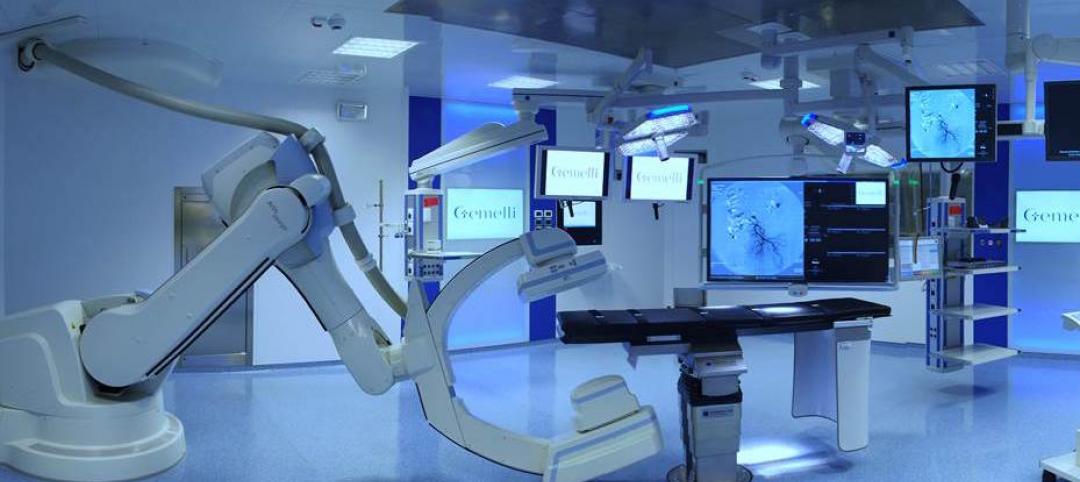With increasing demand to reduce the cost of operation, healthcare leadership is challenging their facility engineers to increase efficiency of the buildings they manage. Healthcare owners are struggling with the need to improve the bottom line with limited capital to spend on projects even with the best rate of return. The return on investment is typically much more attractive and more visible when related to the addition of clinical services as opposed to an investment in infrastructure.
However, studies have shown that when looking at the total lifecycle cost for a healthcare facility, 87 percent of the total cost is spent once healthcare owners start operating the new facility, with almost half of that cost allocated to utilities. The right approach during the planning, design and construction of a new facility can yield a positive return on investment and lower the overall cost basis for ongoing operations.
Form Follows Function
As with any new endeavor, the challenge is to have the right strategy, process and tools and then utilize the latest technology and systems to achieve maximum efficiencies. To have effective facility management, healthcare owners must invest the time to determine how to best manage and operate their facilities. With little to no additional premium in construction, systems can be incorporated into the design of a new facility project that will meet the technical capabilities of existing staff. If additional capabilities are required to meet the new systems goals, identification should be made early to allow for proper training and implementation. Additionally, a clear understanding of the volume of operations that will be outsourced will have an impact on the type of systems that will be built. In architecture, the phrase form follows function is often used. This is highly applicable to systems development as well.
Vital to success is the creation of an infrastructure plan concept. Healthcare leadership can implement this critical step in conjunction with a facility master plan. Development of the plan should begin with a review of the following:
1. Hospital leadership’s vision as it relates to focus on “non-core” services
2. Existing staff capabilities and their readiness to maintain complex systems
3. Number of full-time employees and level of staffing
4. Cost of purchasing utilities
5. Level of outsourcing as it relates to preventive maintenance and service contracts
6. Availability of skilled workforce in the market
7. Hospital’s financial strength to absorb the skilled workforce
8. Structure - single entity or part of a larger system
9. Level of sharing workforce within the hospital system
10. Centralization options within the system
11. Standardization within the hospital system (inventory and purchasing strength)
12. Method of acquiring and purchasing service contracts
13. Number and location of off-site facilities — owned verses leased
14. Energy baseline for the existing facilities
15. Level of modernization and implementation of the right technology
Reviewing, evaluating and developing strategies to close the gaps in the data discussed above forms the basis of an infrastructure plan concept.
As more hospitals are becoming part of larger systems, opportunities exist to capitalize on the economies of scale. Healthcare leaders are experiencing increased responsibility for managing multiple locations, many of which are off-site. Centralizing operations, negotiating and bundling service contracts for the entire system, implementing the right technology to network all facilities, eliminating duplications with staffing and “right staffing” are all areas in which savings can be realized.
To reduce the utility costs, many are negotiating new purchasing agreements utilizing large purchasing groups. However, the demand side of business requires additional investments to also reduce the cost of consumption. With limited resources and capital available, creative measures that require minimal investment need to be implemented to reduce the demand.
Streamlining Operations
● Utilize the latest in technology to reduce the energy cost and improve staffing efficiencies by standardizations, centralizations and sharing resources. Examples of these initiatives include ensuring all systems are commissioned during any new installation and identifying the utility baseline and Energy Star rating and comparing to industry standards.
● Conduct retro-commissioning of the existing systems at locations where there are opportunities to reduce cost. Identify any deficiencies and shortcomings. Opportunities to reduce cost may be as important as reducing liabilities by ensuring systems are operating optimally, per code and can provide patient comfort and safety.
● Ensure that existing service contractors and staff make necessary corrections to systems. Typically most are processed through the existing maintenance work order system. Experience has shown that the majority of such corrections require minimum investments.
● Provide continuous commissioning via a remote monitoring program to identify “bad habits” and modify the way the systems are maintained and operated in order to reduce costs.
● Make adjustments and correct bad habits to optimize performance and reduce energy consumption. These adjustments typically require limited expenditure.
● Utilize technology to share information between facilities and improve staff efficiencies. Examples are dispatching more trained staff from a central location or reduce the staffing on remote locations by reporting alarms to a central location.
It should be noted that the latter steps cannot be implemented unless more advanced energy management and remote monitoring capabilities are in place. The implementation of such technologies will be cost prohibitive unless implemented while a major capital project takes place. This re-emphasizes the importance of planning and having the right process in place during project launch and delivery.
Conclusion
Ultimately, the direction taken to create a more efficient building and systems must be strategic. If an organization is planning a capital expansion there will be more tools and options with which to work. However, if there is no immediate capital plan to be the catalyst for this effort, then retrofit tactics could be employed. By following a structured plan through the capital delivery process a more efficient building can be achieved. The simplistic formula begins with the right concept that is an extension of the strategic vision.
Related Stories
Healthcare Facilities | Jul 1, 2016
AIA releases summary of the 2016 Design and Health Research Consortium
Consortium members discussed how architects, designers, and health professionals can best apply design and health research in their communities.
Healthcare Facilities | Jun 19, 2016
Rapid growth of retail health clinics presents new choices for consumers, payers, and providers
Service expansions help dealers boost clinics’ profitability.
Healthcare Facilities | Jun 10, 2016
Top 10 health technology hazards include some influenced by space design
ECRI Institute’s annual list includes operational and workflow issues.
Healthcare Facilities | May 30, 2016
CBRE finds that investors are still flocking to healthcare sector
Over the past year, healthcare accounted for nearly one-fifth of all new jobs in the U.S.
Big Data | May 27, 2016
Analytics alone won't save money for healthcare facility owners
Advanced technology provides insight into the actions necessary to cut costs, but it's the people, processes, and implementation that make a difference with analytics, writes CBRE's Paul Oswald.
Hospital Design Trends | May 19, 2016
CannonDesign releases new white paper on advancements in operating room environments
"Surgical Suites: Emerging Approaches to Planning and Design" offers solutions for collaboration and technology integration.
Healthcare Facilities | May 6, 2016
Infographic: The greening of healthcare
By adopting green building and sustainable practices, healthcare facilities can save $15 billion over 10 years. Skanska's infographic spells it all out.
Healthcare Facilities | Apr 29, 2016
How improving emergency department design leads to greater hospital efficiency
Efficient ED operations result in shorter wait times, quicker diagnosis and care plans, maximum utilization of high-cost human and physical resources, and overall better patient experiences and patient satisfaction scores, writes CBRE Healthcare's Curtis Skolnick.
Healthcare Facilities | Apr 24, 2016
A symposium in New Jersey examines how a consolidating healthcare industry can better manage its excess real estate
As service providers position themselves closer to their communities, they are looking for ways to redirect non-core buildings and land for other purposes.
Senior Living Design | Apr 14, 2016
Creating a home for eldercare using the ‘Green House’ design concept
VOA Associates’ Douglas King offers design considerations in implementing the Green House concept in eldercare for continuing care retirement communities.















